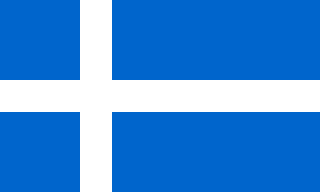
Shetland, also called the Shetland Islands and formerly Zetland, is an archipelago in Scotland lying between Orkney, the Faroe Islands, and Norway. It is the northernmost region of the United Kingdom.

In evolutionary ecology, a parasitoid is an organism that lives in close association with its host at the host's expense, eventually resulting in the death of the host. Parasitoidism is one of six major evolutionary strategies within parasitism, distinguished by the fatal prognosis for the host, which makes the strategy close to predation.

Aquatic insects or water insects live some portion of their life cycle in the water. They feed in the same ways as other insects. Some diving insects, such as predatory diving beetles, can hunt for food underwater where land-living insects cannot compete.
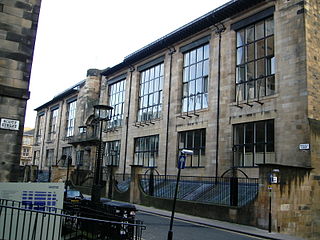
The Glasgow School of Art is a higher education art school based in Glasgow, Scotland, offering undergraduate degrees, post-graduate awards, and PhDs in architecture, fine art, and design.

The Hunterian is a complex of museums located in and operated by the University of Glasgow in Glasgow, Scotland. It is the oldest museum in Scotland. It covers the Hunterian Museum, the Hunterian Art Gallery, the Mackintosh House, the Zoology Museum and the Anatomy Museum, which are all located in various buildings on the main campus of the university in the west end of Glasgow.
Unst is one of the North Isles of the Shetland Islands, Scotland. It is the northernmost of the inhabited British Isles and is the third-largest island in Shetland after Mainland and Yell. It has an area of 46 sq mi (120 km2).

Scalloway Castle is a tower house in Scalloway, on the Shetland Mainland, the largest island in the Shetland Islands of Scotland. The tower was built in 1600 by Patrick Stewart, 2nd Earl of Orkney, during his brief period as de facto ruler of Shetland.
Robert McLachlan FRS was an English entomologist specializing in the study of lacewings (Neuroptera) and caddisflies (Trichoptera).
Alfred Edwin Eaton was an English clergyman and entomologist. He served as the vicar of Shepton Montague in Somerset. His main interests among insects were the Diptera and Ephemeroptera.
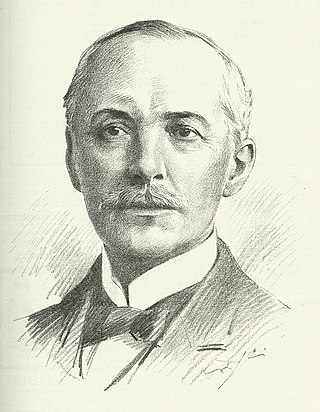
Sir John James Burnet was a Scottish Edwardian architect who was noted for a number of prominent buildings in Glasgow and London. He was the son of the architect John Burnet, and later went into partnership with his father, joining an architectural firm which would become an influential force in British Modern architecture in the 20th century.
Shetland literature is literature written in Shetland, Scotland, or by writers from Shetland. The literature is often written in Shetland dialect or its parent language, Norn, and often depicts the history and folklore of Shetland. Common themes include reflections on island life and proximity to the sea, it is fishing and crofting traditions, the weather and seasons as determined by Shetland's climate, Shetland's unique landscape, its flora and fauna, and the influence of the people's Viking heritage. Folklore often displays features seen similarly in Scandinavia and some Celtic traditions.
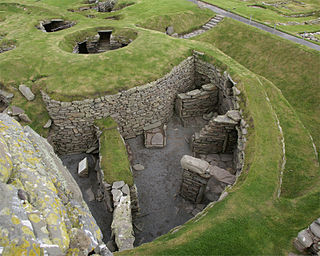
Prehistoric Shetland refers to the prehistoric period of the Shetland archipelago of Scotland, when it was first occupied by humans. The period prior to human settlement in Shetland is known as the geology of Scotland. Prehistory in Shetland does not end until the beginning of the Early Medieval Period in Scotland, around AD 600. More than 5,000 archaeological sites have been recorded in the Shetland Islands.
Events from the year 1978 in Scotland.

John Keppie was a Glasgow architect and artist. From an early age he was a close friend of Edward Atkinson Hornel and would often bring in New Year with him in Kirkcudbright. Within the architectural profession, he was closest to John Archibald Campbell, and is credited with training Charles Rennie Mackintosh.
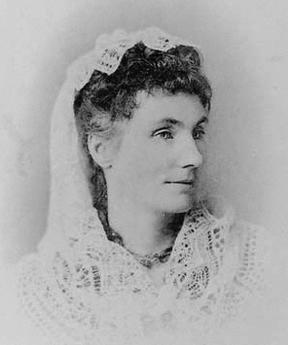
Jessie Margaret Edmondston Saxby was an author and folklorist from Unst, one of the Shetland Islands of Scotland. She also had political interests and was a suffragette.
Martin Ephraim Mosely was an English entomologist who specialized in the systematics of caddisflies (Trichoptera). His interest in freshwater insects was first triggered by his interest in fishing. He was also a well-known angler and fly-fisherman and contributed to the works of Frederic M. Halford, a friend and distant relative.
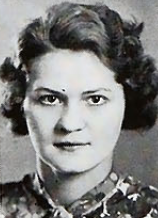
Sophy I. Parfin was an American entomologist associated with the National Museum of Natural History.
Dr Derek Arthur Lott F.E.S. was a British entomologist and museum curator, known for his studies of Coleoptera and biodiversity recording.
Douglas Eric Kimmins was a British entomologist.
Stanley Norman Aflalo Jacobs (1896-1989) was a British entomologist and illustrator. Jacobs worked for many years at the British Museum and was an expert on Pyralid moths.









